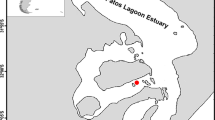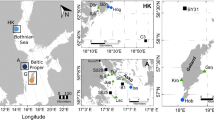Abstract
Trace elements and stable isotopes are commonly used in chronologically formed biominerals as proxies of temperature and/or salinity in estuarine and marine environments. To accurately use the chemistry of biominerals as salinity proxies, understanding the consistency of dissolved element-salinity relationships across spatiotemporal scales is essential. We examined relationships between dissolved Ba:Ca, Sr:Ca, Mg:Ca, Mn:Ca, δ18O, and salinity on regional, local, and seasonal scales in the lower portions of subtropical estuaries (salinities 15–42 ppt) of Texas, including locations where seasonal alternations between negative and positive estuaries can occur. Across all spatiotemporal scales, Ba:Ca displayed a negative linear relationship within the sampled salinity range and was elevated at sites furthest from the ocean and lowest at locations closest to the Gulf of Mexico. This pattern remained consistent as the neutral estuary switched from negative to positive after a rain event. On regional scales, δ18O displayed a positive linear relationship with salinity and was strongly related to evaporation rates. On local and seasonal scales, evaporation-enriched δ18O at upper enclosed estuarine sites and this pattern was consistent over time including periods of reverse estuary conditions. Dissolved Sr:Ca and Mg:Ca varied linearly with salinity on regional scales but displayed minimal variation across temporal scales within an estuary. High variability in dissolved Mn:Ca-salinity relations was found at all spatiotemporal scales, with localized episodic peaks of Mn:Ca possibly due to sediment disturbance. Although dissolved Ba:Ca and δ18O were not predictably related to salinity on local scales, consistent up-estuary enrichment and lower-estuary depletion make these two constituents reliable proxies for animal movements across the ocean–estuary gradient as recorded in chronologically formed biominerals.







Similar content being viewed by others
References
Atkinson, C.A., D.F. Jolley, and S.L. Simpson. 2007. Effect of overlying water pH, dissolved oxygen, salinity and sediment disturbances on metal release and sequestration from metal contaminated marine sediments. Chemosphere 69: 1428–37. doi:10.1016/j.chemosphere.2007.04.068.
Benoit, G., S.D. Oktay-Marshall, A. Cantu II, E.M. Hood, C.H. Coleman, M.O. Corapcioglu, and P.H. Santschi. 1994. Partitioning of Cu, Pb, Ag, Zn, Fe, Al, and Mn between filter-retained particles, colloids, and solution in six Texas estuaries. Marine Chemistry 45: 307–336.
Coffey, M., F. Dehairs, O. Collette, G. Luther, T. Church, and T. Jickells. 1997. The behaviour of dissolved barium in estuaries. Estuarine, Coastal and Shelf Science 45: 113–121.
Cooper, L.W., T.E. Whitledge, J.M. Grebmeier, and T. Weingartner. 1997. The nutrient, salinity, and stable oxygen isotope composition of Bering and Chukchi Seas waters in and near the Bering Strait. Journal of Geophysical Research 102: 12563–12573.
Diouf, K., J. Panfili, M. Labonne, C. Aliaume, J. Tomás, and T. Do. Chi. 2006. Effects of salinity on stronitum:calcium ratios in the otoliths of the West African black-chinned tilapia Sarotherodon melanotheron in a hypersaline estuary. Environmental Biology of Fishes 77: 9–20. doi:10.1007/s10641-006-9048-x.
Dorval, E., C.M. Jones, and R. Hannigan. 2005. Chemistry of surface waters: distinguishing fine-scale differences in sea grass habitats of Chesapeake Bay. Limnology and Oceanography 50: 1073–1083. doi:10.4319/lo.2005.50.4.1073.
Elsdon, T.S., and B.M. Gillanders. 2006. Temporal variability in strontium, calcium, barium, and manganese in estuaries: implications for reconstructing environmental histories of fish from chemicals in calcified structures. Estuarine, Coastal and Shelf Science 66: 147–156. doi:10.1016/j.ecss.2005.08.004.
Flint, R.W. 1985. Long-term estuarine variability and associated biological response. Estuaries 8: 158–169.
Fry, B. 2002. Conservative mixing of stable isotopes across estuarine salinity gradients: a conceptual framework for monitoring watershed influences on downstream fisheries production. Estuaries 25: 264–271.
Gillanders, B.M., and A.R. Munro. 2012. Hypersaline waters pose new challenges for reconstructing environmental histories of fish based on otolith chemistry. Limnology and Oceanography 57: 1136–1148. doi:10.4319/lo.2012.57.4.1136.
Hanor, J.S., and L.H. Chan. 1977. Non-conservative behavior of barium during mixing of Mississippi River and Gulf of Mexico waters. Earth and Planetary Science Letters 37: 242–250.
Ingram, B.L., M.E. Conrad, and J.C. Ingle. 1996. Stable isotope and salinity systematics in estuarine waters and carbonates: San Francisco Bay. Geochimica et Cosmochimica Acta 60: 455–467. doi:10.1016/0016-7037(95)00398-3.
Joung, D., and A.M. Shiller. 2013. Trace element distributions in the water column near the Deepwater Horizon well blowout. Environmental Science & Technology 47: 21612168. doi:10.1021/es303167p.
Joung, D., and A.M. Shiller. 2014. Dissolved barium behavior in Lousiana Shelf waters affected by the Mississippi/Atchafalaya River mixing zone. Geochimica et Cosmochimica Acta 141: 301–313.
Klinkhammer, G.P., and J. McManus. 2001. Dissolved manganese in the Columbia River estuary: production in the water column. Geochimica et Cosmochimica Acta 65: 2835–2841.
Kowalski, N., O. Dellwig, M. Beck, M. Grunwald, C.-D. Dürselen, T.H. Badewien, H.-J. Brumsack, J.E.E. van Beusekom, and M.E. Böttcher. 2012. A comparative study of manganese dynamics in the water column and sediments of intertidal systems of the North Sea. Estuarine, Coastal and Shelf Science 100: 3–17. doi:10.1016/j.ecss.2011.03.011.
Kraus, R.T., and D.H. Secor. 2004. Incorporation of strontium into otoliths of an estuarine fish. Journal of Experimental Marine Biology and Ecology 302: 85–106. doi:10.1016/j.jembe.2003.10.004.
Limburg, K.E., C. Olson, Y. Walther, D. Dale, C.P. Slomp, and H. Høie. 2011. Tracking Baltic hypoxia and cod migration over millennia with natural tags. Proceedings of the National Academy of Sciences of the United States of America 108: E177–82. doi:10.1073/pnas.1100684108.
Limburg, K.E., B.D. Walther, Z. Lu, G. Jackman, J. Mohan, Y. Walther, A. Nissling, P.K. Weber, and A.K. Schmitt. 2014. In search of the dead zone: Use of otoliths for tracking fish exposure to hypoxia. Journal of Marine Systems 1–12.
Middelburg, J.J., H. Van Der Cornelis, W. Weijden and J.R.W. Woittiez. 1988. Chemical processes affecting the mobility of major, minor, and trace elements during weathering of granitic rocks. Chemical Geology 68: 253–273.
Mohan, J.A., R.A. Rulifson, D. Reide Corbett, and N.M. Halden. 2012. Validation of oligohaline elemental otolith signatures of striped bass by use of in situ caging experiments and water chemistry. Marine and Coastal Fisheries 4: 57–70. doi:10.1080/19425120.2012.656533.
Mooney, R.F., and J.W. McClelland. 2012. Watershed export events and ecosystem responses in the Mission–Aransas National Estuarine Research Reserve, South Texas. Estuaries and Coasts 35: 1468–1485. doi:10.1007/s12237-012-9537-4.
Morris, A.W., R.F.C. Mantoura, A.J. Bale, and R.J.M. Howland. 1978. Very low salinity regions of estuaries: important sites for chemical and biological reactions. Nature 274: 678–680.
Negrel, P., C.J. Allegre, B. Dupre, and E. Lewin. 1993. Erosion sources determined by inversion of major and trace element ratios and strontium isotopic ratios in river water: the Congo Basin case. Earth and Planetary Science Letters 120: 59–76.
Nielsen-Gammon, J., F. Zhang, A. Odins, and B. Myoung. 2005. Extreme rainfall in Texas: patterns and predictability. Physical Geography 26: 340–364. doi:10.2747/0272-3646.26.5.340.
Pakhomova, S.V., P.O.J. Hall, M. Yu. Kononets, A.G. Rozanov, A. Tengberg, and A.V. Vershinin. 2007. Fluxes of iron and manganese across the sediment–water interface under various redox conditions. Marine Chemistry 107: 319–331. doi:10.1016/j.marchem.2007.06.001.
Paucot, H., and R. Wollast. 1997. Transport and transformation of trace metals in the Scheldt estuary. Marine Chemistry 58: 229–244. doi:10.1016/S0304-4203(97)00037-6.
Richard, D., B. Sunby, and A. Mucci. 2013. Kinetics of manganese adsorption, desorption, and oxidation in coastal marine sediments. Limnology and Oceanography 58: 987–996.
Shaw, T.J., W.S. Moore, J. Kloepfer, and M.A. Sochaski. 1998. The flux of barium to the coastal waters of the southeastern USA: the importance of submarine groundwater discharge. Geochimica et Cosmochimica Acta 62: 3047–3054.
Shiller, A.M. 1997. Dissolved trace elements in the Mississippi River: seasonal, interannual, and decadal variability. Geochimica et Cosmochimica Acta 61: 4321–4330. doi:10.1016/S0016-7037(97)00245-7.
Sinclair, D.J., and M.T. McCulloch. 2004. Corals record low mobile barium concentrations in the Burdekin River during the 1974 flood: evidence for limited Ba supply to rivers? Palaeogeography, Palaeoclimatology, Palaeoecology 214: 155–174. doi:10.1016/j.palaeo.2004.07.028.
Stalker, J.C., R.M. Price, and P.K. Swart. 2009. Determining spatial and temporal inputs of freshwater, including submarine groundwater discharge, to a subtropical estuary using geochemical tracers, Biscayne Bay, South Florida. Estuaries and Coasts 32: 694–708. doi:10.1007/s12237-009-9155-y.
Statham, P.J., D.P. Connelly, C.R. German, T. Brand, J.O. Overnell, E. Bulukin, N. Millard, et al. 2005. Spatially complex distribution of dissolved manganese in a fjord as revealed by high-resolution in situ sensing using the autonomous underwater vehicle Autosub. Environmental Science Technology 39: 9440–9445.
Stecher, H.A., and M.B. Kogut. 1999. Rapid barium removal in the Delaware estuary. Geochimica et Cosmochimica Acta 63: 1003–1012.
Thamdrup, B., R.N. Glud, and J.W. Hansen. 1994. Manganese oxidation and in situ manganese fluxes from a coastal sediment. Geochimica et Cosmochimica Acta 58: 2563–2570.
Tolan, J.M. 2007. El Niño-Southern Oscillation impacts translated to the watershed scale: estuarine salinity patterns along the Texas Gulf Coast, 1982 to 2004. Estuarine, Coastal and Shelf Science 72: 247–260. doi:10.1016/j.ecss.2006.10.018.
Trefry, J.H., and B.J. Presley. 1982. Manganese fluxes from Mississippi Delta sediments. Geochimica et Cosmochimica Acta 46: 1715–1726.
Walther, B.D., and M.K. Nims. 2014. Spatiotemporal variation of trace elements and stable isotopes in subtropical estuaries: I. Freshwater endmembers and mixing curves. Estuaries and Coasts. doi:10.1007/s12237-014-9881-7.
Ward, G.H. 2010. Inflows to San Antonio Bay. Austin: Center of Research in Water Resources, University of Texas at Austin.
Wen, L.-s., P. Santschi, G. Gill, and C. Paternostro. 1999. Estuarine trace metal distributions in Galveston Bay: importance of colloidal forms in the speciation of the dissolved phase. Marine Chemistry 63: 185–212.
Zhang, J. 1995. Geochemistry of trace metals from Chinese river/estuary systems: an overview. Estuarine, Coastal and Shelf Science 41: 631–658. doi:10.1006/ecss.1995.0082.
Zwolsman, J.J.G., and G.T.M. van Eck. 1999. Geochemistry of major elements and trace metals in suspended matter of the Scheldt estuary, southwest Netherlands. Marine Chemistry 66: 91–111. doi:10.1016/S0304-4203(99)00026-2.
Acknowledgments
We are much obliged for the assistance of J. Barnes, D. Breecker, J. Banner, and N. Miller at the Jackson School of Geosciences for help with sample analysis and R. Mooney, B. Dean, L. Pollard, and staff at the Texas Parks and Wildlife Department for help with sample collection. Helpful comments were provided by G. Ward, two anonymous reviewers, and editor D. Swaney that considerably improved the manuscript. This work was conducted in part in the Mission-Aransas National Estuarine Research Reserve, part of the National Estuarine Reserve System under an award from the Estuarine Reserves Division, Office of Ocean and Coastal Resource Management, National Ocean Service, and National Oceanic and Atmospheric Administration. Funding during this study was provided by Mission-Aransas National Estuarine Research Reserve GRA to J. Mohan and EPA STAR fellowship to J. Mohan.
Author information
Authors and Affiliations
Corresponding author
Additional information
Communicated by Dennis Swaney
Electronic supplementary material
Below is the link to the electronic supplementary material.
Supplemental material
(XLS 66.5 kb)
Rights and permissions
About this article
Cite this article
Mohan, J.A., Walther, B.D. Spatiotemporal Variation of Trace Elements and Stable Isotopes in Subtropical Estuaries: II. Regional, Local, and Seasonal Salinity-Element Relationships. Estuaries and Coasts 38, 769–781 (2015). https://doi.org/10.1007/s12237-014-9876-4
Received:
Revised:
Accepted:
Published:
Issue Date:
DOI: https://doi.org/10.1007/s12237-014-9876-4




